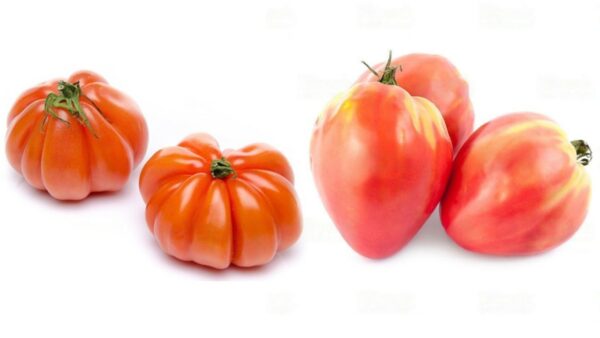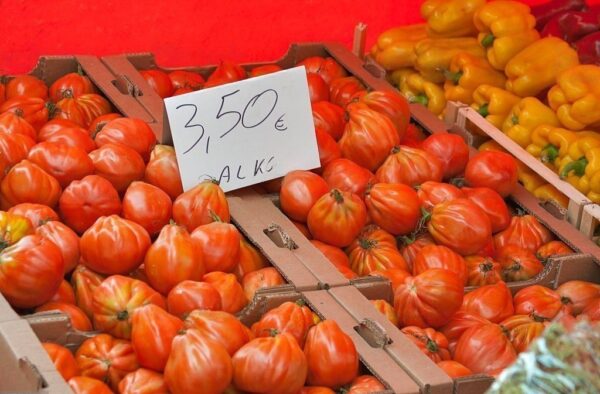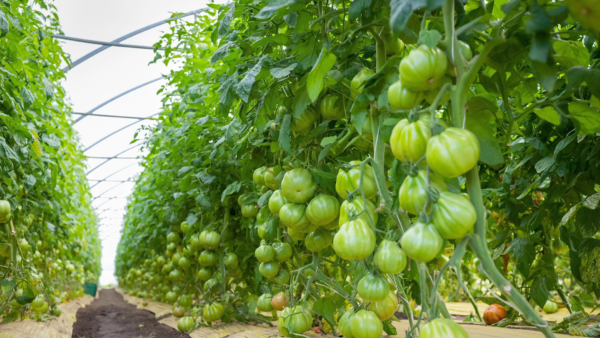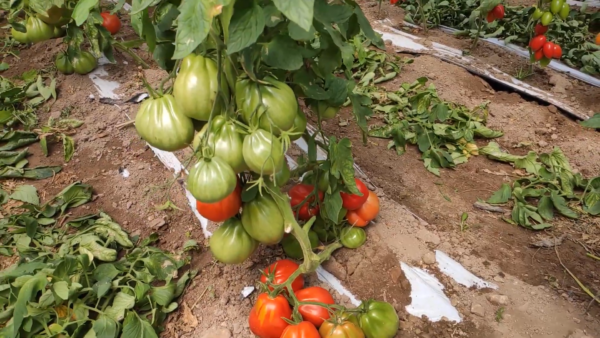We’re back again with the next installment of: Know Your Italian Tomatoes! Today we’ll be discussing everything you need to know about another delicious Italian tomato, the Cuore di Bue (also known as the Oxheart) – including what to cook with them and how to get your hands on them.
General Description
“Cuore di bue” is Italian for “ox heart”, but in English, we most commonly refer to them as “oxheart” tomatoes (one word). The oxheart’s key defining characteristic is that it is tapered on one end and somewhat resembles a heart, and is a very large tomato so it must be the heart of an ox. Very appropriate naming!
There’s a twist though – while all cuore di bue tomatoes have a distinctive heart shape, there are two different heart shapes that are both referred to as oxhearts (and as cuore di bue). One is very similar to the original oxheart from the US – with an elongated, tapered bottom. There is another version with a “piriform” shape that is much closer to the shape of a pear – wider at the bottom than the top.

The oxheart is a variety of tomato originally grown in the early 20th century, purportedly in the US in the state of Virginia. It turns out there are a LOT of different oxheart varieties these days, but today (and always) we’ll be focused on the Italian variety. The range of coloration of for oxhearts is incredibly wide – orangey-red typically, with or without green shoulders is standard, but they can also be found in deep red, pink, orange, green, and even purple.
These tomatoes are classified as an heirloom beefsteak variety. The name beefsteak refers to the fact that they are meaty – there is a lot of flesh and not a lot of seeds. Also, they’re very large in stature. These are some of the largest tomatoes grown in Italy, and can easily grow to be the size of a softball and weigh up to a pound each. In fact, 3-pound cuor di bue are not unheard of.
The piriform oxheart looks pretty similar to costoluto tomatoes in that it has a ribbed shape. but the oxheart’s ribs are not as deep, have a bottom-heavy shape, and they tend to be more symmetrical than the costolutos.
Oxheart Nutrition
There isn’t a huge amount of variation in the nutritional profile of different types of tomatoes.
All tomatoes are famous for being high in lycopene – an antioxidant known to have positive effects on aging and inhibit certain types of cancer. Unless you’re on an acid-restricted diet tomatoes are great for you, and costolutos are definitely included in that list.
Oxheart recipes
There are many, many dishes that oxhearts would be appropriate for. First and foremost are fresh tomato recipes. These tomatoes have such a great taste and texture you can eat them like tomatoes. They’ll obviously be excellent for classic dishes like Bruschetta and Caprese salad.
Just because they’re great fresh doesn’t mean they’re not wonderful for cooking though – especially in sauces and soups. I haven’t done it yet, but would love to try making passata with them.
Recipe roundup
Here are some links to recipes that would be great with Cuore di Bue tomatoes…
- Bruschetta Trio
- Rustic Summer Tomato Tart (Italian Food Forever)
- Tuscan Pomarola Tomato Sauce with Mixed Pasta (The Pasta Project)
- Insalata di Pomodoro (Trepunti Sicily)
- Ligurian Baked Stuffed Tomatoes (A Small Kitchen In Genoa)

Oxheart Substitute
Let’s say you see this in a recipe but can’t figure out where to buy them – this is no problem. Honestly, you’re more likely to have the other problem – you have gotten your hands on some delicious cuore di bue tomatoes and you want to substitute them into a recipe that calls for another type of tomato. In either case, here are a handful of ideal substitutes:
- Costoluto Genovese or Costoluto Fiorentino – very similar Italian beefsteak varieties, these are a bit sweeter than the Cuore di Bue, but are pretty similar in size, shape, and texture to the oxheart
- Costoluto Pachino – very similar to the other Costoluto tomatoes, this is another delicious, large, ribbed tomato that will be fantastic if you can get your hands on them.
- Pantano – a large, fleshy tomato with low acid, very few seeds, and an incredible taste. The tops may stay green even when fully ripe, so there’d be a bit of an interesting color.
- Red Pear Franchi – another beefsteak that’s great for slicing, low acidity, very fleshy with few seeds, and sweet.
- Cherokee Purple – Not Italian, but a beefsteak variety originating in North Carolina. As the others, large, fleshy, small seed pockets. This is named after a coloration that “looks like a leg bruise” – it’s much darker both inside and out, and keeps some dark green mottled color even after fully ripening.
- Brandywine – Another beefsteak tomato originating in the US, this tomato has a pink-red color inside and out with green shoulders. It’s a bit more acidic than most of the others, but similarly has low seeds and is an excellent sweet flavor.
Where to Buy Oxheart Tomatoes
Fresh
Your best bet at getting your hands on some Cuore di Bue tomatoes will probably be to find them at a farmers’ market. As an heirloom variety, you’re unlikely to find these at your local grocery store so hopefully the local farmers in your area like growing a wide array of varieties. Even if you don’t see any for sale, it wouldn’t hurt to ask folks selling heirloom tomatoes if they are familiar with them and if they know anyone that may have them.
If you don’t have a great farmers’ market nearby, your next best bet would be to go to your favorite Italian restaurant and ask the chef. They’re likely to have a connection for less common Italian ingredients and may be able to hook you up. Yeah, it almost sounds like a drug deal.
The best bet of all is to grow your own. More on that below

Canned
I searched high and low but I had no luck at any of my local Italian delis. I did however find one place online to order jarred passata. These unfortunately aren’t whole tomatoes, but you should be able to use this passata for soups and sauces. One unfortunate detail for those of us far outside of Italy – this place doesn’t ship outside of Europe!
Passata di Pomodori Cuor di Bue Cruda (Silvano Romani)
How to grow Oxheart tomatoes
If you live in a climate that can grow tomato plants, I’d highly recommend growing your own. It’s a labor of love, but nothing is better than picking a tomato off a plant and eating it that day.
Starting Seeds
Sowing tomatoes directly in the ground is not at all advisable. Start the seeds in starter pots with starter soil, 1/4″ deep in moist but not damp soil. At 2″ tall you’ll probably want to transplant them into 4″ pots. This should help to avoid the seedlings getting root bound before transplanting.
The seeds don’t like cold soil. If you’re not starting the seedlings in a heated building a heating pad can really help. Make sure the soil temps are between 70-90°F.
After spotting the first set of true leaves, be sure to fertilize regularly. Use 1/2 strength organic fertilizer until transplanting.
Transplanting
They’ll be safe to transplant when the overnight low temp doesn’t drop below 55°F. If everything is timed perfectly, the seedlings should be about 7-8 weeks old, or 5-6″ tall.
Plant them deeply in the soil – you can bury the bottom 2/3rds of the plant in the soil. Tomato plants are really cool, the little white “hairs” on the stem are called trichomes and will become roots if they detect they’re buried.
Staking or wire cages should be set up when first transplanted – this will help the plants stay off the ground when the tomatoes grow heavy.
Growing
Pick a spot with full sun exposure. The more sun, the better. Plants should be planted about 2 to 3 feet apart.
The soil should ideally be amended with aged manure or compost if available, or granular organic fertilizer if not. You’ll want to continuously provide fertilizer as they grow.
Surround the plants with lots of mulch to help retain moisture in the soil and prevent overheating in hot climates. These plants are generally pretty tolerant of heat, but production can drop if they overheat. You might need to set up a sunshade if the daytime temperature breaks 100 regularly.
Cuore di Bue are indeterminant plants, meaning they will continue to grow and produce as long as the conditions (temperature, sunlight, water, nutrients) allow.

Harvesting
As soon as a tomato turns fully red (possibly with green shoulders) and has a little give to it when you squeeze it (gently!) then that thing is ripe. This should most likely take around 80-90 days.

Buying Seeds
Cuore di Bue seeds are really easy to find online. Here are a few places you can buy seeds online if your local nursery doesn’t carry them…
Where to Buy Oxheart Seeds:
